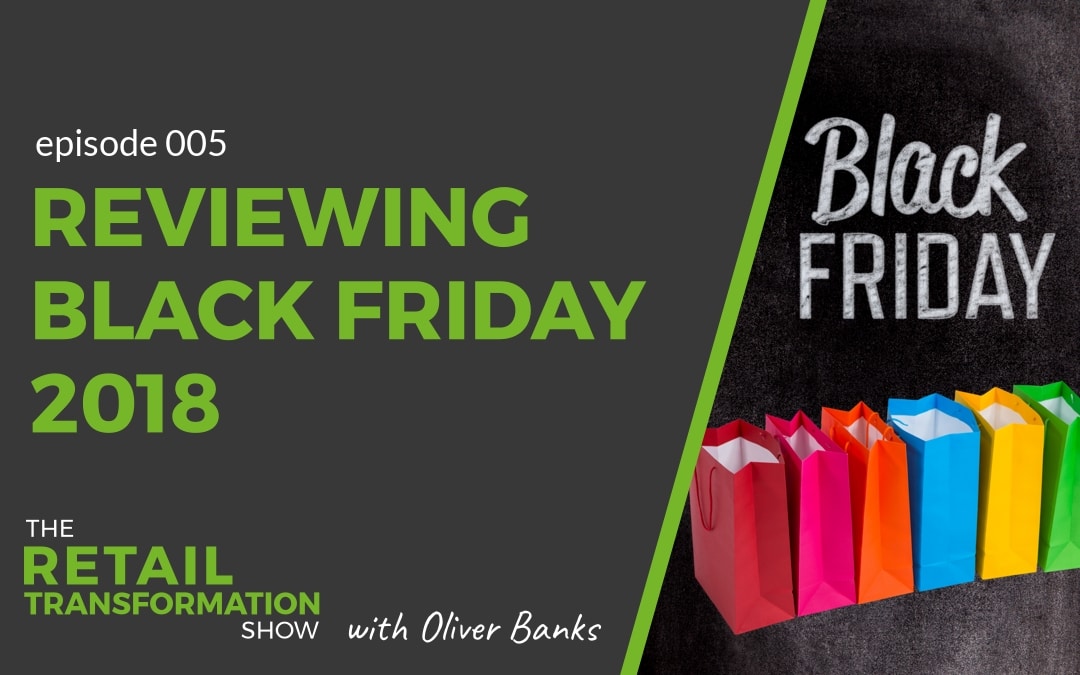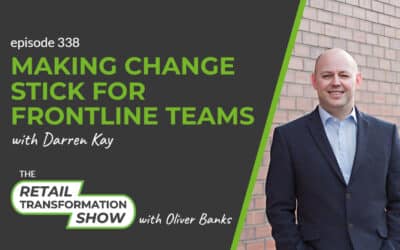Customers view Black Friday as perhaps the most important retail event of the year. A great chance to make some expensive purchases with a heavy discount or getting those special Christmas presents at a lower price. Whilst it is a great trade opportunity for retailers, how should your operation be set up to take advantage of this opportunity? In episode 5, I explore what happened on Black Friday 2018, what it means for the future and what you need to do about it now.
Key trends from Black Friday 2018
This year, one of the important trends observed is the shift to online shopping. Whilst this eases the strain on stores, it transfers the pressure to a different part of the business. The sudden influx of ecommerce sales can cause major issues to your operations.
This year, there were several trends observed:
- Greater focus on online shopping.
- Mobile shopping takes more market share.
- Fewer discounts available.
Some interesting statistics referenced in the show include:
- Argos reported in the Guardian that 50% of orders by Friday morning were made on a mobile device. This was up from last year’s 40%.
- Meanwhile, Carphone Warehouse saw smartphone sales increase 8% year on year.
- Research firm GfK reported that only one third of laptops were discounted on Black Friday 2018. This is significantly down compared to 70% last year. Also, the average price drop was 8.9% this year compared with 9.5% last year.
Websites took a much heavier toll than stores this year. Among the big name brands to suffer website outage were:
- In the US: Walmart, Lowe’s and J.Crew.
- In the UK: John Lewis, Debenhams, Game, and Superdrug.
But Black Friday isn’t for everyone
“Black Friday is pointless” says George Weston of Primark
Primark’s focus is on providing value all year around rather than on funding sales for a few particular days. Companies like Apple and Ikea also feel the same way.
But some companies, like Asda and Homebase, took part again this year after not engaging in 2017.
What did Amazon do well
Amazon hosted an extended Black Friday event from 16th November to 25th November. That’s 9 days. Plus, we can now see that Cyber Monday for Amazon will last from 26th November to 30th November. That’s another 5 days, so 2 weeks in total.

They focused on a few key lines throughout this, like their Echo smart speakers and Fire TV sticks. Other lines swapped in and out every 24 hours.
With this strategy, they created a strong sense of urgency for customers. By adding timers and stock visibility, they inspired the fear of missing out (FOMO) for customers. With the changing offers, they also encouraged customers to keep coming back for more.
Meanwhile, their focus on reducing the number of SKUs meant that they could streamline their operation without having a general sales uplift across their entire range.
But they also suffered from worker dissatisfaction with strikes staged at depots before Black Friday.
How should you improve for next year?
Mark the date in your diary. Friday 29th November 2019. The next Black Friday.
The first step is to take Lessons Learnt. These need to be done now as some transformations will take time to come to fruition. Especially if they need capital investment or software and systems development.
But my request to you is this.
Do lessons learned BUT don’t let them get forgotten.
It’s all too easy to review this year and promptly file it away and never remember the mistakes you made and the opportunities open to you. So instead, mark the date in your diaries to review 6 months before next Black Friday, then again 3 months before and once again 1 month before.
Don’t make the same mistakes again and again. Learn from the lessons you experience.
Other actions that we spoke about in the podcast were:
1. Website availability
This will help with planning your expected traffic and the operational surge. Your site obviously needs to stay up to make sales in an online driven event. Also, fairly obviously, you need to be able to process and fulfil the orders.
Make sure you use as much data as possible to understand what happened this year. Extrapolate what you can to be able to plan effectively for Black Friday in 2019.
Look at the patterns for online vs offline. Investigate the split between mobile vs desktop shopping. What can your website analytics tell you? Are there trends for days or times of day?
2. Coping with operational surge
With the shift to online, you need to be able to fulfil these orders. Use analytics and insight to help guide you. Which areas are going to experience the biggest uplifts? What lines will be the best sellers over the busy period?
You need to be able to streamline processes. It doesn’t make sense to increase capacity to deal with the volume that you’ll experience for only a few days per year.
Another point for you to consider: how can the surge be funnelled into more predictable areas or spread over more days. What can you learn from what Amazon did this year?
3. Dealing with customer returns
The challenge is that there is very little visibility of what’s coming and when. But, customers demand a fast turnaround on getting their money back into their accounts.
Make sure you collect data on why customers are returning goods so you can take more specific action to investigate further.
Also, make sure that you streamline your processes to remove waste.
Connect with Oliver Banks
Now, tell me, are we connected on LinkedIn already? If not, please do reach out and let me know that you’re a listener. Here’s the link to my profile.
Or email me at oliver.banks@obandco.uk or fill in my Contact form.
Resources referenced in the show
Adobe Analytics reported that (as of 8pm EST on Black Friday 2018) consumers had already spent $4.1 billion. That’s a 23% increase year on year. Reported in the New York Times.
Less fighting on Black Friday 2018 – phew! Read more about how this was received in the US, reported by New York Times.
OpenX did a survey and found that 59% of US shoppers were planning on avoiding bricks and mortar stores on Black Friday. Read more about the OpenX research.
Increased focus on mobile shopping, including stats about Argos and Carphone Warehouse picking up more trade through mobile devices and smartphones. Reported by the Guardian.
Plenty of useful Black Friday stats from the UK market, including differences across genders, geography and generation. Read more on Finder.com.
Plus even more stats for the UK and US markets are available from WeAreTop10.com.
And finally, a report on Amazon’s warehouse troubles as reported in the Telegraph.







![337: [Show Update] Pressing Pause to Refocus](https://obandco.uk/wp-content/uploads/2025/07/337-Show-Update-Pressing-Pause-to-Refocus-1080x675px-400x250.jpeg)